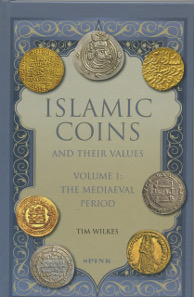Tim Wilkes, Islamic Coins & Their Values. Volume 1: The Mediaeval Period. Spink, London, 2015. 285 pages, coloured illustrations. Hardcover, 14,5 x 22,3 cm. 978-1-907-427-49-7. GBP 40.
First of all, do not expect too much of this book. It is what the Swiss call “sec”, an outright consistently dry basic list of Islamic coins. Chronologically, it focuses on the Middle Ages, on the period between the 7th and the 16th century. Arranged partly according to dynasties, partly to geographical units, the different denominations are presented here, classified according to ruler. Number, name of ruler, and denomination are stated. That’s it. Nothing else.
In most cases an illustration is provided, as well as an assessment in US dollars for every single number, except for extremely rare pieces. You will find brief historico-numismatic introductions and – highly convenient – the relevant specialist literature, if existing.
Of course, one could have wished for any amount of additional information. But then again this book would never have been published. And that would have been a pity: concise and richly illustrated, it is ideal especially for those who cannot read Arabic. It can be flipped through, from beginning to end, to find the coin lying in front of you. The three small appendices with the names of Arabic mints, Arabic numbers and names of Arabic rulers are very helpful in this regard.
We must not forget that this is the first edition of a catalog which, thanks to the increasing interest in the Islamic world, will be reprinted again and again in the years to come. It is a very useful tool, which, certainly and very soon, nobody would like to do without anymore. The numbering “Volume 1” points to a follow-up, dealing with the modern era, which the author is currently working on. He attends many coin fairs. Therefore, talk to him about the information you would like to see included. I for one would wish for an Arabic alphabet and a schematic drawing for the large series – the Abbasids, for example – which can tell me where to find which information on the coin.
But this is only one of many possible suggestions. First of all, it is an achievement in itself that this catalog makes it easier to identify Islamic coins.
You can order the book at Spink.





